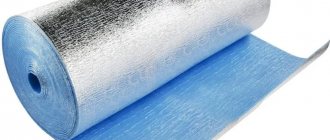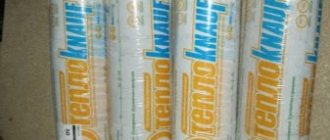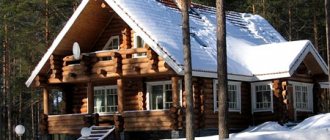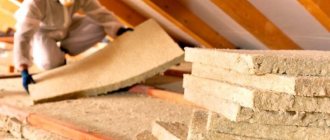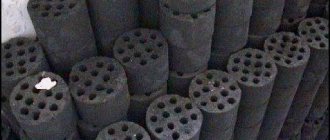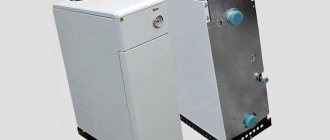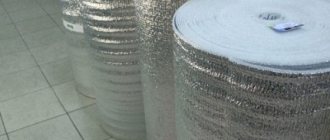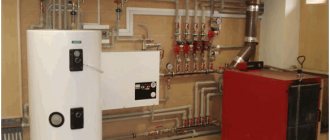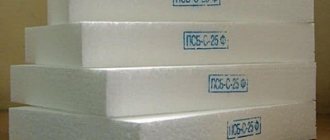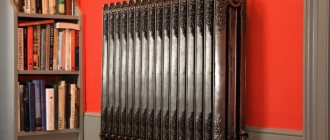Proper insulation with penofol on the outside of a wooden house helps to transfer the dew point beyond the boundaries of the wooden walls, which in turn protects the building itself from the harmful influence of the external environment. Why is this happening? Because the freezing of wooden walls is not uniform (especially if we talk not about the perimeter, but about the thickness of the material).
Only the outer surface is characterized by negative temperatures, which provokes the formation of moisture, which acts as a destroyer on the structure. In addition, wood slowly absorbs and accumulates moisture, which leads to mold beginning to multiply throughout the material.
What it is?
Penofol is a two-layer heat-insulating building material, which can be made from one or 2 layers of foil applied to a base layer of polyethylene foam. Depending on the type of product, the density and thickness of the foam may vary. Utilitarian and inexpensive insulation is in great demand among buyers, because it has high performance characteristics.
A layer of foil, the thickness of which is 20 microns, provides penofol with excellent heat-reflecting qualities.
This insulation is used in everyday life and industry as the main insulating material or as an auxiliary thermal insulation layer.
Penofol is used as the main insulating material in cases where it is necessary to insulate a room with normal heat loss and where there is a powerful heating source (bathhouse, sauna, underfloor heating system in a wooden house). As an additional insulating building material, penofol is used to create complex heat insulation in residential and industrial premises, and such premises must be equipped with vapor barrier and waterproofing.
Thermal insulation of wooden walls with Penofol
In this case, the work is somewhat different, since wood itself is already a warm material. But, despite the fact that such a surface has a “breathing” ability, retains heat and helps create a favorable microclimate, warm air can still leak out into the street. During use, wood undergoes some shrinkage under the influence of natural and climatic factors. This causes the appearance of fresh cracks, cracks, and other unfavorable places. The tightness is broken, which leads to the need to apply a heat-insulating layer. Before carrying out insulation work on wooden walls, you need to make sure what type of wood they are made of. This is due to the fact that different varieties and species of wood have different thermal insulation characteristics. All this leads to the fact that the costs of insulation may vary. It is the lack of external insulation that leads to the need for internal thermal insulation of walls. Penofol in this case is perfect, especially if you combine it with other materials. Work on insulating a wooden house is carried out according to the following algorithm:
- Insulation of wooden walls from the inside with Penofol should begin with sealing the cracks and gaps that form naturally in the wood. It is recommended to pay special attention to checking joints, window frames, door frames, and corners.
- Making a frame for a heat insulator for wooden walls is not necessary.
- If sheet Penofol with one-sided foil is used, then it is the side with foil that should be facing the sheathing, that is, inside the room.
- A sharp knife is used to cut strips.
- The strips are attached using special staples and a powerful construction stapler. At the same time, they should be in close contact with each other so that there is no free space between them.
- To secure the joints, they are glued with aluminum tape. This will provide a smooth and uniform reflective surface.
- Maintaining an air gap is a mandatory factor for effective insulation and the absence of condensation. The air space must pass between the material and the wall.
- Wooden blocks are placed on top of the insulator, which will serve as lathing. You can attach chipboard sheets or plastic panels to them. Final finishing occurs in the same way as in the case of concrete walls.
Note! It is necessary to carry out work on the internal insulation of a wooden house after the final shrinkage of its walls and foundation occurs. Usually this happens no earlier than a year after completion of all construction work. How to insulate walls from the inside with Penofol - watch the video:
The attractiveness of Penofol as insulation is largely due to its unique properties. However, we should also pay tribute to its cost, which fluctuates in ranges below the market average.
Advantages and disadvantages
The use of penofol has its advantages:
- The small thickness of the material allows you to create reliable thermal insulation of the room.
- Installation of building materials does not require special skills or special tools. Working with this material is much easier than with other types of insulation.
- The material is environmentally friendly, which makes it possible to use it for storing food.
- Fire safety. This building material belongs to the class of fire-resistant materials.
- Ease of transportation. The thickness of the product allows the insulation to be rolled up, which allows it to be transported in the luggage compartment of a car.
- Excellent sound insulation. Mounting penofol on top of the frame of building structures provides good insulation of extraneous sounds.
Penofol has not only positive qualities. There are also disadvantages to using this building material:
- The insulation is soft. Because of this, this product is not used for finishing plastered walls. When lightly pressed, the material bends.
- To fix the insulation you will need special adhesives. It is not recommended to nail it to the surface, because in this way penofol loses its thermal insulation qualities.
Criterias of choice
To perform high-quality insulation of the floor with penofol, as well as walls and ceilings, it is necessary to choose the right insulation. To do this, you should be guided by the following criteria:
- for ease of installation, it is recommended to choose a material thickness of at least 5 mm;
- when insulating steam rooms, boiler rooms and industrial premises with high temperatures and humidity, it is better to abandon the use of penofol in favor of multilayer materials with increased moisture and heat resistance, for example, foiled polypropylene;
- It is imperative to pay attention to the quality of polishing of the foil and the type of metal from which it is made, since the amount of reflected thermal energy, and, accordingly, the efficiency of the material will depend on this;
- when purchasing the required amount of penofol, it should be taken into account that rolls are sold not by linear meters, but by coverage area, which varies between 9-18 m2;
- It is recommended to either refuse to purchase cross-linked insulation or carefully study the technology as it was done (physical or chemical method), since this criterion has a significant impact on thermal conductivity;
- It is worth paying attention to branded manufacturers who can guarantee the stated technical characteristics.
Floor insulation with penofol
Types of Penofol
There are:
- Penofol "Type A" - aluminum foil on one side, the most widely used option.
- “Type ALP” - the foil is covered with a protective polymer film - is used when contact with concrete, which is aggressive towards aluminum, is possible.
- “Type B” - foil on both sides.
- “Type C” - on one side there is foil, on the other side there is an adhesive layer - the material can be glued to the surface.
- The material with foil, but perforated, is capable of passing steam through it in large quantities; there is no data on vapor permeability from the manufacturer.
There are 3 main types of penofol depending on production technology, dimensions and technical characteristics:
Type A
Polymer insulation material of varying thickness, foil is applied only to one side of the building material. This type of insulation is popular in complex insulation of building structures; it can also be combined with some insulation materials: glass wool, mineral wool.
Type B
Insulation covered with foil on both sides. Thanks to this design, the material has maximum insulation effect.
This type of insulation is used for thermal insulation of load-bearing structures of the attic, waterproofing of basements, floors and walls. Foil material placed under the roof prevents heat from entering the room.
Type C
Self-adhesive penofol, which is covered with foil on one side, and on the other, a thin layer of adhesive composition covered with film is applied to it. Depending on the dimensions of the product, it can be used on almost any surface, which saves time. Before starting work, this building material must be cut into strips of a certain size.
Regular penofol (types: A, B, C) has a white base, while penofol 2000 has a blue base.
There are several other types of penofol, which are not in great demand among consumers.
Type R
One-sided insulation, which has a relief pattern on the foil side of the insulation. It is similar to penofol type A, but is mainly used as a decorative special element for finishing premises.
There is penofol without a foil coating, which does not have a corresponding type, but builders call it a substrate for laminate (linoleum).
This type of insulation has a low cost and is mainly used for thermal insulation of special floor coverings.
Insulation materials with a narrow direction:
- ALP is a material laminated with polyethylene film. Has high reflective properties. Used for insulation of incubators.
- NET - this type of insulation is similar to type B, produced in narrow roll sheets. Used to insulate pipelines.
A novelty in the field of manufacturing polymer insulation materials is perforated penofol. This building material is able to breathe, because it has a large number of micro-holes. Often used to insulate wooden structures.
Air supply options
Ventilation can be natural or mechanical. Natural ventilation is more suitable for indoor spaces, in terms of air movement speed. The air flow rate with such a system is no more than 1 m3 per hour. With mechanical ventilation, this speed increases and is already 4-5m3 per hour. A feature of natural ventilation is the need to increase the cross-sectional diameter of the air ducts. The lower the air speed, the larger the dimensions of the ventilation ducts need to be designed. Here it is already necessary to insulate the air ducts. Self-adhesive penofol is insulation for air ducts, which was specially developed for these purposes. It has an aluminum foil coating and a sticky layer - it is aesthetically pleasing and environmentally friendly. Penofol insulation, the technical characteristics of which are selected taking into account the design documentation. Mineral wool insulation or rubber is used less frequently; there is a risk of condensation.
The natural ventilation system is the simplest and most inexpensive ventilation. To install such ventilation, expensive electrical appliances are not required. This type of ventilation does not consume electricity. To install it, you need air ducts that have a deflector installed at the outlet. It is installed to enhance traction and protect the room from external precipitation through external channels. The main shafts are laid during the construction of the house. They are built from bricks or blocks and are installed above the ridge of the roof. Each room should have its own exhaust duct and duct insulation installed to prevent odors from the kitchen from entering the rooms. When installing a natural exhaust ventilation system, air is removed by the resulting temperature difference, and depends on wind speed and air pressure. When installing a natural design exhaust system, no additional equipment is required and it is easy to maintain. To prevent it from freezing at the outlet in winter, and to prevent air from being blown back in during strong winds, Penofol air duct insulation must be installed on the air duct.
A mechanical ventilation system should be used in cases where the natural one cannot cope. I mainly use it in large rooms, damp and aggressive environments, shopping and industrial centers. When designing, fans, check and direct valves, and insulated air ducts are used. The air outflow process is automatically regulated. The mechanical exhaust design regulates processes independent of the environment. This project is more expensive than natural ventilation and requires connecting electronic devices that provide automatic control to the electrical network. It will be more difficult to maintain. Supply mechanical ventilation additionally heats or cools, conditions, removes dust or humidifies the air entering the room using a heater. Forced supply air displaces the air through a system of exhaust air ducts, which are also insulated; for this purpose, foil-coated air duct insulation with a self-adhesive Penofol layer is used. During operation, it is necessary to periodically clean air ducts and devices.
In ordinary life, a person should feel comfortable in his own home, manufacturing plant or shopping center, store or pharmacy; he must take care of fresh air. If the ventilation system in the room is poor, then the windows fog up, unpleasant odors emanate from the bathrooms, and mold and mildew appear. When these indicators are present in your room, it is necessary to repair the old one or create a new air exchange technology.
There are two main components in any ventilation system. This is analogous to the internal organs for human breathing. A person inhales clean air, processes it and exhales it, which is already depleted of oxygen and polluted. Likewise, in an engineering system, there must be an air inflow and outflow. The level of comfort depends on the temperature and air flow speed. The lower the speed, the more comfortable it is. Air delivery to the premises is provided by air ducts that must be thermally insulated using Penofol duct insulation.
Thermal insulation qualities of Penofol
It should be noted that when compressed to 2–3 times the original thickness, air is partially displaced from the material, and the thermal conductivity coefficient increases significantly. At the same time, reducing the thickness of the layer leads to a proportional decrease in heat transfer resistance. This means, at least, that Penofol, as insulation, should not be used in a compressed state.
On the manufacturer's website you can find the following values:
- heat transfer resistance R of PENOFOL® insulation in a structure with a closed air gap is 1.175 – 1.362 m2C/W.
Apparently, such a high value for a thin layer of insulation was obtained by adding up the heat transfer resistance of directly foamed polyethylene with a thickness of 5 - 10 mm - only 0.15 - 0.3 m2C / W, and also by adding here the heat saving from foil (a barrier for radiant heat), which completely depends on the radiation power from the inside, the temperature in the room, the presence of heating sources, the degree of absorption of radiation by structures, and also, apparently, adding the resistance of the “closed air gap” of the structure, which can actually reach 1.0 m2C/W, for example, in a double-glazed window.
However, the obvious fact is that Penofol really does insulate, all that remains is to apply it correctly.
Dimensions
Penofol is available in rolls of various lengths, the maximum length of which is 30 m. The width of the canvas varies from 0.6 to 1.2 meters. The thickness of the material depends on the type of penofol. Standardized material thickness: 2,3,4,5,8,10 mm. In rare cases, materials with a thickness of 40 mm are produced.
The foil material, which is 1 cm thick, has a high level of noise protection and retains heat much better. Insulation with a thickness of 5 mm, which has high technical characteristics, is very popular.
Penofol is available in rolls. The standard length of rolled sheets depends on the thickness of the building material and can be 5, 10, 15, 30, 50 m.
What to glue it with?
A correctly selected adhesive solution for foil material does not yet guarantee a successful installation. For a quality connection of materials, it is necessary that the surface to be glued be carefully prepared. All defects, irregularities, and various debris must be eliminated.
To improve adhesion, materials made of metal, concrete and wood can be treated with a special primer solution.
Concrete floors and walls are leveled, cracks are sealed, and metal products are treated with an anti-corrosion agent.
Adhesive for foil insulation can be either specialized or universal. You can also use liquid nails, double-sided tape, or a thin layer of foam. The choice of glue depends entirely on the purpose of the surface and its further use.
The adhesive composition must correspond to the performance indicators of the insulating material:
- permission for indoor use;
- the toxicity of the solution should be 0;
- high resistance to adhesion;
- the glue must withstand temperatures in the range of -60 to +100 degrees.
If insulation is carried out externally, then the adhesive solution must be resistant to water vapor and liquid.
In order for penofol to be reliably glued to the surface, the glue must be applied to the side that does not have a foil layer. The adhesive solution is applied evenly, without gaps. The edges of the panel are carefully coated with glue so that the foil material does not come off during operation.
Before you start fixing the penofol, you need to wait 5-60 seconds for the glue to dry slightly. This ensures better adhesion to the products. Penofol is pressed to the surface, holding it, and smoothed out with special care.
If the insulation is glued in pieces, then the joints are additionally glued.
Interesting Facts
A little history and other interesting facts about Penofol:
- Reflective thermal insulation was first used in the United States to create space suits.
- The name “penofol” is derived from two words: polyethylene foam (peno-) and foil (-fol).
- The metallized layer undergoes pre-treatment: polishing to a maximum reflectance coefficient (from 97%).
- The overall coefficient of resistance to thermal transfer of Penofol with a thickness of 10 mm is higher than that of a brick wall with a thickness of 54 cm.
- Each type of Penofol has its own labeling. The letter C corresponds to a self-adhesive foil roll.
- There is a way to check Penofol for quality without leaving the store. Unroll the roll and look through it at a bright light source. This way all irregularities, stripes and spots will be visible.
- You should not buy Penofol labeled 2000; it is a cheaper but lower quality material.
The construction market is overflowing with various proposals, but not all of them fully meet the requirements that apply to them. Penofol products are one of the few that you can trust. Combining several useful properties, self-adhesive foil polyethylene is able to give the room long-awaited warmth.
Ceiling and roof covering
It is proposed to do preliminary insulation of attic roof slopes according to the following scheme (shown above in the drawing):
- Waterproofing - a diffusion membrane - is laid horizontally on top of the rafters, with a minimum overlap of 100 mm. The order of fastening the canvases is from bottom to top.
- The membrane is pressed against the beams with counter-lattice bars, and horizontal boards of the main sheathing are nailed to them. A roofing covering is mounted on top - metal tiles, slate, profiled sheets, and so on.
- From the inside, horizontal beams 50-60 mm thick are attached to the rafters, the installation step is 60 cm.
- Three-layer “Penofol” type B with two foil surfaces is applied to the bars. Note that the thin insulation goes around the rafters so that there is a gap on both sides.
- The internal lining - lining, moisture-resistant plasterboard, chipboard panels or other finishing materials - is vertically screwed to the ends of the bars.
Attention! The Penofol roll is rolled out vertically on the surface, adjacent sheets are laid end-to-end, not overlapping. We carefully seal the seams with aluminum tape.
To seal the joints, use a mounting tape with a width of at least 50 mm.
In this case, the insulation reflects heat flows on both sides, which is very useful in the summer, when the metal roof gets very hot. The inner layer remains unventilated, moisture from the external air is removed through the membrane. Since Penofol serves as a vapor barrier, it is necessary to organize natural exhaust in the attic using a separate ventilation duct.
Please note that there is an inaccuracy in the drawing above - there is no external counter-lattice that creates a ventilation duct above the superdiffusion membrane. In the next version of the diagram, which shows the thermal insulation “pie” of the attic roof, the frame of the sheathing is clearly visible. What is different about this cladding method:
- Between the rafters there is a thick layer of basic insulation - 120-200 mm of mineral wool.
- The bottom of the mineral wool is lined with two-layer “Penofol” type A right along the ends of the beams. The aluminum faces the inside of the attic room, the canvases are turned horizontally.
- A gap of 2-3 cm is left between the polyethylene and mineral wool insulation, and about 4 cm on the foil side.
- We nail the bars for interior finishing to the ends of the beams directly through the layer of polyethylene.
The foil surface faces the inside of the room, a gap is provided between it and the lining.
The section clearly shows that Penofol plays the role of an additional insulator and vapor barrier - traditional film is not used from the inside. The moisture formed in the mineral wool is removed through the upper vent and the waterproofing membrane. Vapors from human activity are removed by supply and exhaust ventilation.
Advice. When working with Penofol, it is important to understand the essence: we always leave a layer in front of the foil, and lay the polyethylene base close to the building structures. We connect the canvases only end-to-end.
Ceilings are insulated according to a similar principle:
- If on the attic side the wooden floor is covered with expanded clay, sawdust or reeds, it is enough to lay 1 layer of “Penofol” type B, creating gaps using lathing.
- Type C material can be glued directly to a concrete ceiling, with the foil facing down. Next, mount the frame for attaching the gypsum board or other finishing.
- When major insulation of the ceiling is necessary, use the attic scheme, only without a membrane and external sheathing. Install a frame of beams or galvanized profiles, insert the main insulation between them, then hem the bottom with type A polyethylene foam.
If Penofol is the only insulator of heat flow (which is not always correct), choose the maximum thickness of the material - 8...10 mm. In tandem with other insulation materials, a sheet with a thickness of 3-4 mm works well.
About the thickness of Penofol
The thicker the insulation, the more expensive it is. And the price and technical characteristics of foil Penofol are influenced by the number of layers of aluminum foil: there can be one or two. As for thickness, its standard sizes are: 10, 8, 5, 4 and 3 millimeters. You can understand that centimeter-thick material with a double layer of foil will be the most expensive. By the way, it not only stores heat better than anyone else, but also protects well from noise.
In terms of optimal price-quality ratio, Penofol with a thickness of 0.5 centimeters came out on top. If maximum thermal insulation, as well as protection from noise and moisture, is required, then it is better to opt for a centimeter layer of Penofol. As for the other parameters of the insulation, they also depend on the thickness of its layer, as well as on its type.
About Penofol's heat conductivity
Since this insulation is combined, combining heat reflection and absorption, it is difficult to compare it with traditional heat insulators. Penofol insulation helps reduce convection due to the polyethylene foam layer, and the foil layer on the outside can reflect up to 97% of heat rays. The result is comprehensive insulation.
And yet, let’s try to compare, if not the thermal conductivity coefficient, but the heat transfer resistance of Penofol and other insulation materials. If we take this material with a thickness of 4 to 5 millimeters, covered on both sides with aluminum foil, we get a heat transfer resistance of 1.2 to 1.23 square meters-degrees Celsius per watt. To achieve the same result, the layer of mineral wool should be no less than 8 or 8.5 centimeters. Data are calculated according to SNIP II-3-79.
About the material's absorption of water
Penofol almost does not absorb moisture, and it does not matter what humidity the air has indoors and outdoors. This does not depend on the change of season or change in temperature. This distinguishes this insulation from most modern heat insulators.
About the vapor permeability of Penofol
There is no need to lay a vapor barrier film when using Penofol. After all, its vapor permeability coefficient does not even reach 0.001 milligrams per meter-hour-Pascal. We can say that this insulation is an excellent barrier to fumes.
Sound resistance
Speaking about the sound absorption of Penofol, we can name the following number: 32 decibels. This is precisely the sound absorption that class “A” material has. It is mounted not inside the frame of the building structure, but on top of it, with no seams. Therefore, it allows you to protect yourself from various noises: both acoustic and structural. This versatility is a definite plus.
Fire protection
According to the standards, this material is classified as substances that are difficult to burn and do not support combustion. The Research Institute of Construction Physics issued Penofol a certificate of conformity confirming that the material is not a fire hazard. When burned, polyethylene releases water and carbon dioxide. True, if there is not enough oxygen, carbon monoxide may appear.
Service life and safety
One of the cleanest materials in terms of ecology is polyethylene foam. Therefore, it is this that underlies Penofol. By the way, in terms of durability (200 years) this substance can be given the highest score. At the same time, you will be able to protect yourself from the harmful effects of electromagnetic radiation. They can be reduced by two or even ten times.
Balcony insulation with foam plastic
This type of thermal insulation is recommended to be installed at temperatures ranging from -5 to +30 degrees. To securely fasten it, it is recommended to use glue and fasteners. An adhesive is applied to the sheets and then pressed against the wall.
Typically, builders glue the foam using a gun filled with polyurethane foam. One cylinder is enough to treat 10 square meters.
Dry adhesive mixtures are suitable for insulating a balcony with polystyrene foam inside and out; they can be used to attach the sheets to a wooden sheathing. But dry mixtures are not suitable for fastening to concrete.
It is not recommended to use liquid nails; they do not create sufficient fixation. But nails harden quickly, so they are often used in combination with long-drying foam or glue. In this case, you will not have to put up supports to prevent the sheet from falling before the foam hardens.
To secure the foam securely, it is advisable to use fasteners. They can be combined with glue or used instead. For this operation, a mushroom dowel is used, which does not cause deformation of the thermal insulation.
Insulating a balcony with polystyrene foam step by step:
- Select the dowels according to their length - they must pass through the material, a layer of glue and old plaster. Next, the fasteners penetrate the concrete to a depth of at least 50 mm, and the curvature of the wall must be taken into account. Typically, for foam plastic 50 mm thick, a dowel 110 mm long is enough.
- Holes are drilled in the foam that will be used for fixation. For 1 m2, six holes are enough - four in the corners and two in the center.
- Screw the mushroom dowel using a screwdriver; if fasteners with a nail are used, it is simply driven in with a hammer.
After installation, it is recommended to cover the foam with a mesh and apply reinforcing glue on top. You can attach trim on top of it. It is advisable that the reinforcing adhesive be made by the same manufacturer as the fastening adhesive.
When insulating a floor with polystyrene foam, logs from timber are first installed, then sheets are laid between the sheathing. The remaining gaps are sealed with polyurethane foam. The material should be flush with the wooden beam. The top is covered with plywood.
You can insulate the floor without installing a frame. But in this case, you will have to put a reinforcing mesh on top, and then make a concrete screed. This method is rarely used, since performing the screed requires some skills.
Both frame and frameless methods are suitable for attaching polystyrene foam to the ceiling. If wooden lathing is used, a layer of film must be placed between the frame and the material to avoid the formation of condensation. The foam is cut exactly to the size of the cells, since it is not subject to deformation. If the sheets are glued with glue, several additional fasteners are installed. For finishing you can use sheets of plasterboard.
Examples of incorrect and dangerous use of Penofol
- Laying Penfol under a cement (reinforced concrete) screed. The foil is destroyed by the alkaline aggression of concrete, the insulation layer is compressed excessively. There is no warming effect.
- The use of Penofol as the main insulation layer in structures that must be insulated in accordance with standards - in floors, in roofs, in walls. In this case, users are usually guided by the assurances of sellers that the material replaces “5 centimeters of polystyrene foam” or “6 centimeters of mineral wool.” As a result, without a main insulating layer (in most cases, 10 cm of effective insulation is economically optimal...), the structures remain cold.
- Application from the side of the living space directly onto Penofol, without leaving an air gap, finishing panels, wooden finishing, wood structures, which entails dampening of the finishing, mold development, wood rotting due to condensation accumulated on the vapor barrier insulation. After a year of such use, according to the owners, Penofol is “black with mold.”
- Laying inside panel structures along the foil side of the electrical wiring.
- Joining Penofol sheets leaving gaps, which, in addition to a general reduction in insulation, in some structures leaves greater air permeability (drafts), which completely eliminates the presence of an insulating layer.
Advantages
Not only the technical characteristics of Penofol indicate a large number of its advantages, there are also other advantages. An affordable price will allow you to buy a product for insulating large rooms. It is perfect for installation in a spacious living room or for use in a conference room.
Visual photos of Penofol show how simple and at the same time effective its structure is. Additional sound insulation will improve the comfort of staying or living in the room. Minimal moisture absorption indicates the possibility of installation in the kitchen.
Useful information and video on how to insulate an attic for winter living
A lot depends on the quality insulation of the attic roof. If you plan to use this space during the winter, you need to think carefully about what materials to use for insulation. Another important aspect is the roof design.
If the roof geometry is very complex, you may have to sacrifice some area to retain heat
The peculiarity of the under-roof space is not only in geometry; in winter it is colder here than in other rooms, and in summer it is hotter. To maintain optimal temperature, roofers recommend forming a multi-layer “pie” of waterproofing, vapor barrier and insulation under the roofing.
High-quality thermal insulation will prevent heating of the roofing material and the formation of ice
And now a short video to get a general idea of attic insulation:
Preparatory work
Before insulating the roof, it is necessary to go through the preparatory stage of work, which is always carried out according to the standard scheme:
Inspection of roof truss elements for damage in the form of cracks or rot. If any are found, beams, bars and boards should be replaced.
Cleaning the inner surface of roof slopes from dirt. These could be stains of rust and grease, dust, traces of mold and the like.
Coating wooden roof elements with antiseptics, fire retardants and primer.
How to use
Foil materials are used to insulate floors, walls, doors, and insulate pipelines. With their help, it is easy to increase the heat transfer of batteries. The main installation rule: the foil should be directed inward, since this layer reflects heat back into the room.
Rules for installing self-adhesive Penofol:
- The layers are cut with a sharp knife.
- The layers should be placed strictly end-to-end and not overlapping.
- The wiring must be insulated.
- The installation joints are covered with self-adhesive aluminum tape to ensure complete sealing.
- If installation is carried out outside, then you must wait for dry and warm weather.
- Any surfaces are pre-cleaned of dust and dirt and, if possible, degreased.
- If the floor is covered, then the edges of the roll should extend at least 10 cm onto the walls.
- It is necessary to create a ventilation gap between the wall and the covering, since Penofol does not conduct moisture, and it will accumulate and moisten other structural elements. To do this, special slats are attached to the surface, and Penofol is placed on them.
Insulating the attic from the inside if the roof is already covered: work procedure and useful tips
A cold attic can be converted into a full-fledged living space. It differs from the attic in ceiling height - at least 2.5 m. Sometimes it protrudes beyond the living quarters and is supported on stilts. You can arrange an empty space yourself, following simple but mandatory rules. The arrangement of the attic should begin with the main thing - with insulation.
If the roof is already covered, insulating the attic from the inside may seem like a more complicated process. However, everything is not as complicated as it might seem, the main thing is to follow the order of work and choose the right materials.
If the roof is already covered: insulating the attic from the inside according to all the rules
Reading time: 7 minutes No time?
We will send the material to you by e-mail
Whether you are building a new structure or remodeling the roof for additional rooms, you need to take care of how to properly insulate the attic. If the roof is already covered, all work from the inside is carried out taking into account the geometry of the roof and the climatic characteristics of the region. In this material, we have collected all the necessary information about possible insulation methods and will provide you with practical recommendations from professionals.
A well-insulated attic can serve as a bedroom or even a children's room
Answers to popular questions
What is the best insulation for an attic under metal tiles?
Metal tiles do not place any special requirements on insulation. All types of mineral wool and foam plastics are suitable. The main condition is a sufficient layer of insulation, reliable waterproofing and vapor barrier.
Soundproofing insulation should be installed under a metal roof. Basalt wool and polystyrene foam have these qualities. In addition, roll and block insulation materials with a soundproofing substrate are produced.
How to insulate an attic if the roof is without waterproofing
If there is no waterproofing, it should be installed. With a cold roof, the absence of a water barrier is not critical - if there is no difference in the external and internal temperatures, there will be no condensation, as well as ice dams.
The waterproofing film can be laid from the inside, securely connecting the joints. In this case, the need for ventilation under the roofing should be taken into account. Therefore, there must be an additional sheathing above the waterproofing film to create a ventilation gap. If there is no gap, the roofing material is laid on the rafters, then it must be removed.
Waterproofing is laid on top, connected without gaps, sheathing is made and the roofing is installed.
Installation features
Laying penofol is carried out with the foil side always towards the heat, so that it could be reflected into the room. To eliminate the risk of condensation, a ventilation gap of at least 10-20 mm wide is formed on this side. The edges of adjacent workpieces are joined closely without overlap. To ensure the integrity of the protective layer, the seams are additionally sealed with aluminum vapor barrier tape.
sealing seams with aluminum tape Source neoenerg.ru
For walls, it is recommended to choose samples up to 5 mm thick with one foil side. If such a fabric is insufficiently effective, you should first insulate the room with penoplex. It is better not to use mineral wool boards in order to avoid assembling additional sheathing.
Penofol can be attached to walls by gluing it to a clean primed surface or using a construction stapler (with staples). A counter-lattice made of slats or plywood pieces is mounted on top of the insulator. Drywall, chipboard or other rigid sheet materials are sewn onto the finished frame.
